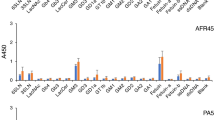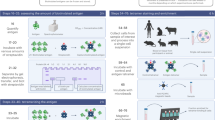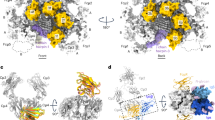Abstract
ANALYSIS of mouse B-lymphocyte surface immunoglobulin (Ig) by isotopic labelling techniques reveals little, if any, IgA or IgG. Instead, the surface Ig consists of monomeric IgM and an Ig similar in physicochemical properties to human IgD1–3. In the absence of sequence comparison between human IgD and its assumed mouse counterpart, this assignment is tentative. With this proviso, however, and for the sake of clarity in presentation, we refer to this immunoglobulin as IgD. During development, IgM-bearing cells are the first to arise and the ratio of IgM–IgD determined with labelled adult lymphocytes is higher in the spleen than in lymph nodes or Peyer's patches1,4. These findings, however, give the total yield of the two Ig classes and not their distribution on individual lymphocytes. On the basis of the absence of immunoglobulins other than IgM or IgD on the surface of B lymphocytes, we indicated the presence of cells bearing IgM or IgD, or IgM and IgD in mouse spleen cell suspensions5,6. In these experiments, IgM was first capped with rhodamine-labelled anti-μ and subsequent ring staining with fluorescein-labelled anti-Fab in the presence of sodium azide was taken as evidence for the presence of IgD. We report here the preparation of an antibody specific for mouse IgD, and its use in the characterisation of mouse B-lymphocyte surface Ig.
This is a preview of subscription content, access via your institution
Access options
Subscribe to this journal
Receive 51 print issues and online access
$199.00 per year
only $3.90 per issue
Buy this article
- Purchase on Springer Link
- Instant access to full article PDF
Prices may be subject to local taxes which are calculated during checkout
Similar content being viewed by others
References
Abney, E. R., and Parkhouse, R. M. E., Nature, 252, 600–602 (1974).
Melcher, U., et al., J. exp. Med., 140, 1427–1431 (1974).
Vitetta, E. S., et al., J. exp. Med., 141, 206–215 (1975).
Vitetta, E. S., McWilliams, M., Philips-Quagliata, J. M., Lamm, M. E., and Uhr, J. W., J. Immun., 115, 603–605 (1975).
Parkhouse, R. M. E., Hunter, I. R., and Abney, E. R., Immunology (in the press).
Parkhouse, R. M. E., and Abney, E. R., in Membrane Receptors of Lymphocytes (edit. by Seligmann, M. Preud'homme, J-L. and Kourilsky, F. M.), 51–56 (Masson, Paris, 1975).
Crumpton, M. J., and Snary, D., Contemp. Topics molec. Immun., 3, 27–56 (1974).
Axen, R., Porath, J., and Ernback, S., Nature, 214, 1302–1304 (1967).
Parkhouse, R. M. E., and Askonas, B. A., Biochem. J., 115, 163–169 (1969).
Cebra, J. J., and Goldstein, G., J. Immun., 95, 230–245 (1965).
Raff, M. C., Immunology, 19, 637–650 (1970).
Julius, M. H., Simpson, E., and Herzenberg, L. A., Eur. J. Immun., 3, 645–649 (1973).
Knapp, W., Bolhuis, R. L. H., Radl, J., and Hijmans, W., J. Immun., 111, 1295–1298 (1973).
Rowe, D. S., Hug, K., Forni, L., and Pernis, B., J. exp. Med., 138, 965–972 (1973).
Jones, P. P., Craig, S. W., Cebra, J. J., and Herzenberg, L. A., J. exp. Med., 140, 452–469 (1974).
Salsano, P., Froland, S. S., Natvig, J. B., and Michaelsen, T. E., Scand J. Immun., 3, 841–846 (1974).
Williamson, A. R., Nature, 231, 359–362 (1971).
Marchalonis, J. J., Cone, R. E., and Santer, V., Biochem. J., 124, 921–927 (1971).
Hunter, W. M., and Greenwood, F. C., Nature, 194, 495–496 (1962).
Knopf, P. M., Parkhouse, R. M. E., and Lennox, E. S., Proc. natn. Acad. Sci. U.S.A., 58, 2288–2295 (1967).
Author information
Authors and Affiliations
Rights and permissions
About this article
Cite this article
ABNEY, E., HUNTER, I. & PARKHOUSE, R. Preparation and characterisation of an antiserum to the mouse candidate for immunoglobulin D. Nature 259, 404–406 (1976). https://doi.org/10.1038/259404a0
Received:
Accepted:
Issue Date:
DOI: https://doi.org/10.1038/259404a0
This article is cited by
-
Cross-reactivity of human and a putative pig IgD. pig IgD-like molecules as serum and lymphocyte components
Folia Microbiologica (1983)
-
The appearance of an IgD-like molecule on pig lymphocytes during ontogeny
Folia Microbiologica (1983)
-
Chemical characterisation of the Fab and Fc fragments from surface immunoglobulin
Nature (1980)
-
Recognition of antigens by T lymphocytes
Molecular and Cellular Biochemistry (1978)
-
Allotypes of mouse IgM immunoglobulin
Nature (1977)
Comments
By submitting a comment you agree to abide by our Terms and Community Guidelines. If you find something abusive or that does not comply with our terms or guidelines please flag it as inappropriate.



